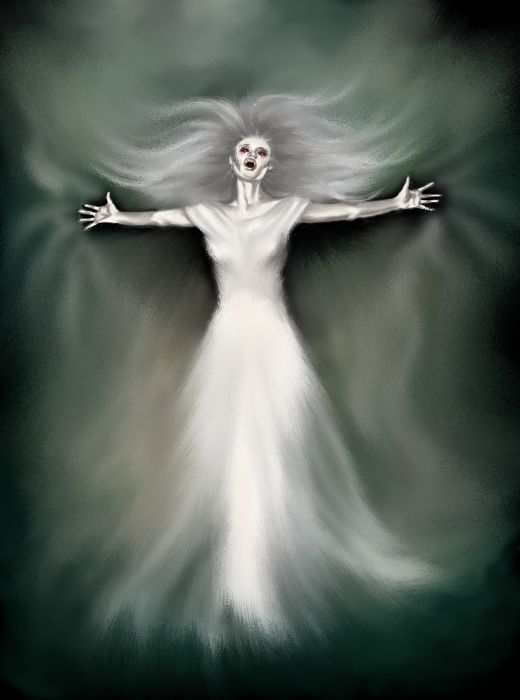
|
The Banshee,
from the Irish bean
sídhe ("woman of the síde"
or "woman of the fairy mounds") is a female spirit in Irish mythology,
usually seen as an omen of death and a messenger from the Otherworld. Her Scottish
counterpart is the bean shìth (also spelled
bean-shìdh).
The aos
sí (people of the mounds, people of peace) are variously
believed to be the survivals of pre-Christian Gaelic deities,
spirits of nature, or the ancestors. Some Theosophists and Celtic Christians have referred to the
aos sí as "fallen angels". The story of the bean-sidhe began as a fairy woman keening at the death of important personages. In later
stories, the appearance of the banshee could foretell the death. Banshees were
said to appear for particular Irish families, though which families made it onto
this list varied depending on who was telling the story.
The banshee can appear in a variety of guises. Most often she appears as an
ugly, frightening hag, but can also appear as a stunningly beautiful woman of
any age that suits her. In some tales, the figure who first appears to be a
"banshee" is later revealed to be the Irish battle goddess, the Morrígan. The hag
may also appear as a washer-woman, or bean-nighe (washing woman), and is seen washing
the blood stained clothes or armour of those who are about to die.
Although not always seen, her mourning call is heard, usually at night when
someone is about to die and usually around woods. In 1437, King
James I of Scotland was approached by an Irish seer or banshee who foretold
his murder at the instigation of the Earl of Atholl. This is an example of the
banshee in human form. There are records of several human banshees or prophets
attending the great houses of Ireland and the courts of local Irish kings. In
some parts of Leinster, she is referred to as the bean chaointe (keening
woman) whose wail can be so piercing that it shatters glass. In Kerry in the southwest of
Ireland, her keen is experienced as a "low, pleasant singing"; in Tyrone in the north, as
"the sound of two boards being struck together"; and on Rathlin Island as "a
thin, screeching sound somewhere between the wail of a woman and the moan of an
owl".
The banshee may also appear in a variety of other forms, such as that of a hooded crow,
stoat, hare and weasel -
animals associated in Ireland with witchcraft.
In Irish legend, a banshee wails nearby if someone is about to die. There are
particular families who are believed to have banshees attached to them, and
whose cries herald the death of a member of that family.
Traditionally, when a citizen of an Irish village died, a woman would sing a
lament (in Irish:
caoineadh, [ˈkɰiːnʲə]
or [ˈkiːnʲuː],
"caoin" meaning "to weep, to wail") at their funeral. These women singers
are sometimes referred to as "keeners"
and the best keeners would be in much demand. Legend has it that for five great
Gaelic families — the O'Gradys, the O'Neills, the O'Briens, the O'Connors, and the Kavanaghs — the lament would be sung by a fairy woman;
having foresight, she would sing the lament when a family member died, even if
the person had died far away and news of their death had not yet come, so that
the wailing of the banshee was the first warning the household had of the
death.
In later versions, the banshee might appear before the death and warn the
family by wailing.When several
banshees appeared at once, it indicated the death of someone great or holy.
The tales
sometimes recounted that the woman, though called a fairy, was a ghost, often of
a specific murdered woman, or a woman who died in childbirth.
Banshees are frequently described as dressed in white or grey, often having
long, fair hair which they brush with a silver comb, a detail scholar Patricia
Lysaght attributes to confusion with local mermaid myths. This comb detail is also related to the
centuries-old traditional romantic Irish story that, if you ever see a comb
lying on the ground in Ireland, you must never pick it up, or the banshees (or
mermaids — stories vary), having placed it there to lure unsuspecting humans,
will spirit such gullible humans away. Other stories portray banshees as dressed
in green, red, or black with a grey cloak.
Banshees are common in Irish and Scottish folk stories such as those recorded
by Irish-American writer Herminie T. Kavanagh. They enjoy the same
mythical status in Ireland as fairies
and leprechauns. Banshees continue to appear in modern
fiction that deals with mythology, folklore or the supernatural.
|
 Copyright(c) 2007
- 2020. All rights reserved. Copyright(c) 2007
- 2020. All rights reserved.
|

![]() Copyright(c) 2007
- 2020. All rights reserved.
Copyright(c) 2007
- 2020. All rights reserved.